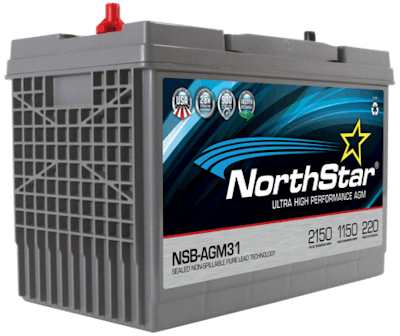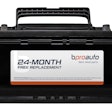 NorthStar batteries feature Absorbed Glass Mat (AGM) technology designed to last four times longer than flooded lead-acid batteries and twice as long conventional AGM batteries.
NorthStar batteries feature Absorbed Glass Mat (AGM) technology designed to last four times longer than flooded lead-acid batteries and twice as long conventional AGM batteries.(HWT Note: This is the third part in a three part series on understanding 12-volt batteries, which includes tips on improving battery function and longevity. The first is titled “Understanding 12-volt batteries: Part 1, corrosion in a connected world”; the second is titled “Understanding 12-volt batteries: Part 2, Fluid depletion and best practices.”)
Jeremy Cordray, electrical engineer and west region manager at NorthStar Battery Company, continues to answer battery-related questions.
HWT: For trucks that are used infrequently and may be parked for long periods of time, what’s the best way to keep the battery in top shape?
Cordray: All electro-chemical storage devices will present a loss of energy over time, even without any parasitic loads. This is termed “self-discharge” and the chemistry and manufacturing of the battery are key elements in identifying the potential for self-discharge. Since the battery is always moving between the charge and discharge sides of the chemical equation, the potential exists for portions of the battery to stay in a discharged state for extended periods of time. This is not optimal for the elements of the battery and will cause sulfation which can cause portions of the battery to become unusable for storage of energy. This can be common in vehicles that are left for extended periods of time. The best way of preventing damage to batteries during long periods of inactivity is to maintain the voltage of the battery at a healthy level. If the battery is fully charge prior to being connected to a maintainer, the process is much simpler, and ensuring the battery’s float voltage and the maintainer are aligned is the focus. However, if the battery is discharged or becomes discharged during the storage, it will require recharge as well as maintaining the float once it has been recharged. In this case, focus on the amperage and voltage parameters to ensure the battery and the charger/maintainer are aligned.
HWT Related: Optima digital battery charger review
HWT Related: Summer battery care important
HWT Related: GM 1500 dual battery upgrade
HWT: What battery technology are you most excited about today?
Cordray: There has been a lot of movement within battery technologies in recent years, however, the lead-acid battery continues to be the predominate energy storage device for the automotive and heavy duty marketplace. The reason lead-acid batteries continue to lead the way is the reliability and efficiency of the chemistry and manufacturing. Just because lead acid batteries have been around for hundreds of years, does not mean the industry is standing still. AGM batteries are growing rapidly and present the marketplace with the ability to increase energy capacity and increase longevity in traditional battery sizes. The introduction of robotics in the manufacturing process is also leading to even greater quality, providing traditional and heavy duty consumers with peace of mind beyond anything previously.
HWT: Please describe NorthStar’s batteries.
Cordray: NorthStar manufactures ultra high performance pure lead AGM batteries for many markets and applications including first responders, heavy duty bus and trucking, as well as high demand marine and specialty audio. With industry leading manufacturing techniques, NorthStar provides the best in quality, reliability, performance, and unsurpassed customer service.










